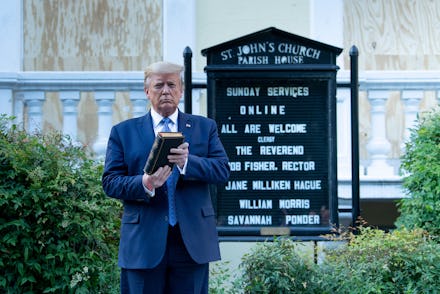How Trump sucked up to the evangelical community

Speaking from the hospital while undergoing treatment for COVID-19, Donald Trump faced the camera and touted therapeutics that “look like miracles coming down from God.”
The choice of words shouldn’t come as a surprise. President Trump has used religious language at a higher rate than any president from the last 100 years. I know this because I have analyzed 448 major public addresses by every president from Franklin D. Roosevelt to Trump for their use of both religious terms and explicit references to God. What I found was the current president uses them at much higher rates than any predecessor. Furthermore, his use of religious language has increased during his presidency.
As a scholar of political communications, I believe Trump’s evolving use of religion in speeches fits into a strategy to appeal to an important part of his voting base: religious conservatives.
Evangelical support
In the 2016 election, Trump won overwhelming support from the white evangelical community. This in itself was not a shock, as the constituency typically votes Republican. But perhaps more surprising was the fact that he received a higher percentage of the white evangelical vote than any previous presidential candidate. Meanwhile, despite his low overall approval ratings, white evangelicals have largely remained loyal in their level of support.
Trump’s policy agenda is largely in line with many white evangelicals’ priorities, such as his support for installing conservative justices on the Supreme Court and promoting the evangelical worldview of the “traditional” family.
Yet, while his agenda in these areas no doubt accounts for much of this continued loyalty, his communications have also played an important role.
Tweeting the God word
My research suggests that President Trump seems to have developed a rhetorical style to appeal to this constituency.
To examine how Trump compares with his predecessors in terms of the language he uses, I looked at the frequency of 111 religious words and phrases established by previous researchers to have, religious — specifically Christian — meaning. These included “pray,” “church,” and “bless” and also variations of each term such as “prayer,” “praying,” and “prayers.”
Within this list were specific “God” terms which consisted of nine explicit references to the Christian God: for example “God,” “Lord,” and “Supreme Being.”
In the presidential speeches I examined, Trump used 7.3 religious terms per thousand words of speech — far higher than any other president from the last 100 years. In fact it was more than double the average rate of 3.5 terms per thousand used by presidents in general. Similarly, explicit mentions of “God” by Trump came at a rate of 1.4 per thousand words — almost three times the average of 0.55.
The average length of presidential speeches in the archive was around 3,000 words, with each speech containing on average 10 religious terms and one or two specific mentions of God. Trump’s speeches were similar in length but contained on average 22 religious terms and four mentions of God.
President Trump also has the speech with the highest rate of use of religious terms: an address following a 2017 Las Vegas mass shooting. That national address contained 52 religious terms per thousand words — although I would note that it was a short speech, only 754 words long. Other presidential speeches following national tragedies — such as the 1986 Challenger disaster, Hurricane Katrina, and the deaths of previous presidents — had a relatively high rate of nine religious terms per thousand words. Yet Trump’s Las Vegas speech is still over five times the average rate for these types of national addresses.
I also examined Trump’s main form of campaign communications: rally speeches and tweets. Looking for the same religious terms and “God” variants, I reviewed 175 rally speeches from June 2016 up to the November 2018 midterms and more than 30,000 tweets from @realDonaldTrump dating from 2009 to November 2017, when Twitter changed the character limit allowed on its messages.
I found that in the 2016 primary campaign, there was almost no religious language in his speeches. Notably, for example, he did not use the almost obligatory presidential speech conclusion asking God to “bless America.” But once he became the official Republican nominee, he sharply increased his use of religious language, and has maintained that high frequency into his presidency.
Interestingly, in speeches in states with a more religious population he used significantly more religious language than in more secular states. In the most religious states, such as Mississippi and Texas, Trump used on average 1.7 religious and 0.36 God terms per thousand words. In the least religious states, like New Hampshire and Maine, these figures were 1.2 and 0.24.
Trump’s prolific tweeting yields some interesting insights. Prior to his inauguration, citizen Trump used just 1.2 religious terms and 0.19 God terms per thousand words in tweets. Yet, President Trump tweets at a rate of 3.2 religious terms and 0.60 God terms per thousand words of tweets — triple his previous rate.
It is unknown how much of Trump’s speeches are written by him personally and how much are simply ad-libbed. Similarly, we don’t know with certainty which tweets are written by Trump personally and which by his staff — a 2017 First Amendment case confirmed that Trump writes most but not all of his tweets. Whatever the truth, both forms of communication are presented as coming from President Trump.
Finding his faith?
My data shows that President Trump has significantly changed how he uses religious language in communications.
Why this is the case is unclear. Some supporters, such as evangelical leader James Dobson, argue that Trump is finding his faith. And it could be that these findings reflect an increasing importance of religion to Trump personally.
Cynics may argue that my data are more reflective of how politically important to him the religious right community is.
This article is originally published on The Conversation by Ceri Hughes at the University of Wisconsin-Madison. Read the original article here.